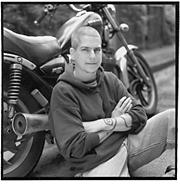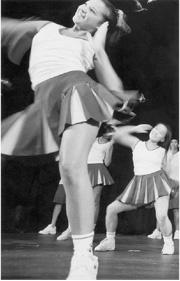Raven Gildea has short, buzzed hair and intense brown eyes. Her left arm is beautifully tattooed with a spiral, Maori-inspired design. She has a goatee. It’s not particularly thick, but it’s distinctive enough that it prompts strangers to ask, “Are you a boy or a girl?”
The question gets asked of many women in Seattle’s butch dyke community. And while many butches don’t like the blatant stares and questions, the thought of conforming to social norms to achieve a more feminine look is equivalent to being locked up in the closet.
Do butch women want to be men? Answers will undoubtedly vary according to individuals, but for Gildea the resounding conclusion is no. “For me, butch means a mix of masculine and feminine characteristics on a female body,” says Gildea.
Her feelings are similar to those of Johnny Otto, a 44-year-old woman whose tall physical bearing, short hair, and baggy, masculine clothing sometimes let her pass for a man. “I consider myself transgendered,” says Otto. “I do feel like a man inside. But my living experience in this body, in this lifetime, has been female, biologically female.” Hmm, sounds like she’s got the worst of both worlds—but then she continues, “I look at various men on the street, and I think, that’s not the kind of man I want to be. If that’s what being a man is, I’ll stay the way I am.”
Contrary to general assumption, many women who exhibit masculine traits are not undergoing hormone therapy, including Gildea, whose goatee is natural. For a long time, beginning in her teen years, Gildea plucked the hairs off her chin out of embarrassment, but now, at 37, she seems quite happy to let them grow. It’s part of her acceptance of her butchness, an identity—along with transgenderedness—embodying both female and male traits, which dykes have increasingly embraced in recent years.
As burdensome as labels can be, there is a difference between the terms dyke and lesbian, as any dyke will tell you. Lesbians—and gays—are more mainstream and have long excluded the “queerer queers”—dykes, nelly queers, drag queens, transsexuals—from their movement in order to be accepted into a predominantly white, middle-class culture. Think of Ellen Degeneres and Rupert Everett as the visible homecoming queen and king.
As a minority within a minority, dykes have had to fight a whole other subset of battles—one of which was inclusion in the local pride parade, the official name of which ignored certain contingents. “Around 1993, I think it was, the words transgender and bisexual were added,” Gildea recalls. “I was part of that struggle to get the name of the parade changed. And I cannot tell you how many gay men there were who were saying, ‘Get your own parade.’ And I was like, ‘I have my own parade. This is it.'”
Yet it may be the success of the more mainstream gay movement that is encouraging a surge of butch and transgender pride. “It used to be a big deal just to come out and be a queer,” says Otto, who came out shortly after the Stonewall Rebellion in 1969. At that time, she recalls, “being androgynous was a way to be butch. [Now] people are pushing the boundaries more, taking a step farther, and I know this is going to push people’s buttons, but it might also be a trendy sort of deal.” She’s noticed more personal ads written by women “actively looking for butches. It’s a desirable thing now—it was pretty rare until a couple of years ago.” She smiles, obviously welcoming the new popularity.
As heirs to the Gay/Lesbian/Bisexual/ Transgender (GLBT) movement, younger dykes may have fewer hang-ups and more choices when expressing their gender identity. Twenty-four-year-old Erin Doherty, who works for Toys in Babeland, has short blue hair a few shades darker than her large, friendly eyes. “I’m really attracted to masculinity that’s not embodied in a biological man. I just find it really, really hot,” she says, making me feel tingly.
“Any time people play with gender, I find it really interesting,” Doherty continues. “I actually have more friends who play with gender than who actually have a specific, rigid gender identity. They can go back and forth from being called he and she and it doesn’t matter. Or they can identify as a boy and a dyke and a lesbian, butch, all at the same time, which gets really complicated, but it’s also really fun.”
Sarah-Katherine Lewis, who is also 24, is a femme dyke attracted to butch women. She thinks other factors may influence the popularity of butches. “You get much more approval from the dyke community with a butch affect and appearance than with a femme one,” she says.
Lewis speaks in a high-pitched, flirtatious voice. Though she is grateful for the struggles made by older feminists, she avoids the term “woman” and calls herself a “girl.” She sometimes poses for porn magazines. She is also the facilitator of a butch/ femme discussion group. At a recent meeting, she had her hair done in braids and wrapped in ribbons like Dorothy in The Wizard of Oz. Her tight, lacy top enhanced her voluptuous breasts. But make no mistake, Lewis is a butch magnet. “I’m gay; my partners are gay,” she explains pointedly.
Lewis observes, “Femmes tend to be invisible within both the lesbian and the straight communities, whereas butches are higher profile and more easily identified.” However, by standing by their butch girlfriends, femme women also challenge traditional concepts of gender.
All this playing around with gender brings into question the validity of mainstream concepts of male and female. Certainly, gender roles have evolved throughout time, especially in the latter half of the 20th century with the sexual revolution and feminist movement. But the categories of male and female remain restrictive. The International Olympic Committee checks athletes to make sure no men are masquerading as women, but the committee’s decisions about how to tell who is a “real” woman keep changing and being challenged. Doctors have historically been baffled by babies born with ambiguous genitals, which occurs in one out of 2,000 births. Usually, a snip here and there was thought to be the solution, a practice that’s been damned by tragic cases such as that of David Reimer, which came to recent public light in the book As Nature Made Him. And while many transgendered people have “normal” genitalia, their extraordinary—and courageous— perspectives often land them somewhere in the middle of male and female.
“The whole world doesn’t know where to put transgendered people,” says Gildea. “Which bathroom do you use if you’re transgendered? There are only two. You have to pick one. The [Olympic] Games are divided into male and female. You have to pick one. The gender designation on your driver’s license is either male or female. You have to pick one. I think it’s wrong that the whole world is set up so you need to choose male or female. I have a gender that’s very complicated. I can’t describe it in 50 words or less.”
Call 322-3953 for more information on the butch/femme discussion group.







